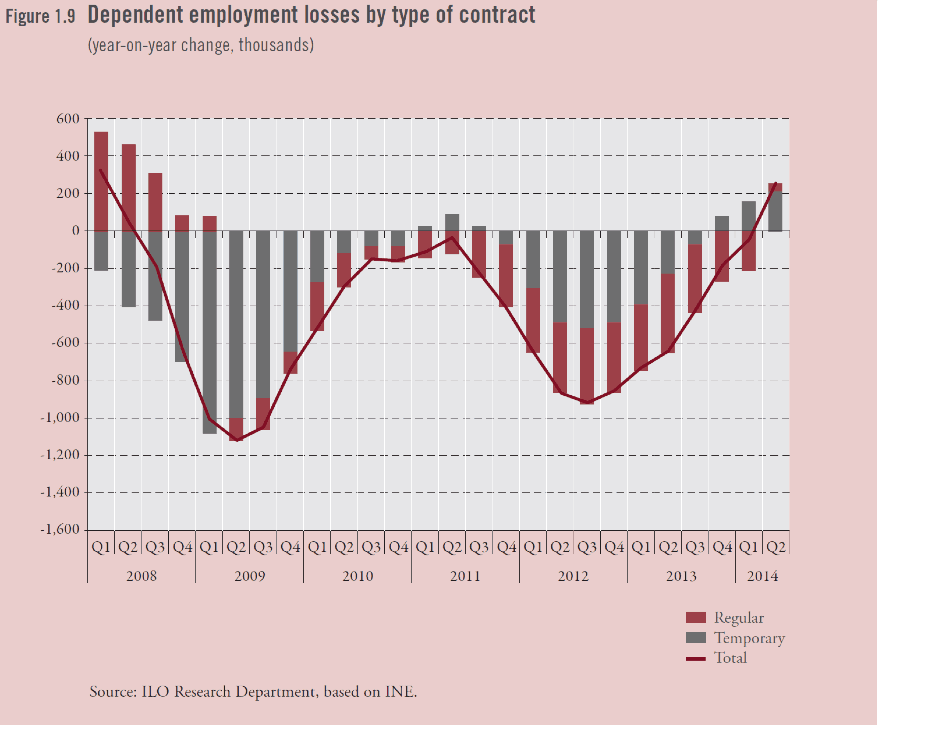
One of the key findings from the 2016 Employment Outlook just released by the OECD is that easier firing does not create jobs. Moreover, the OECD also finds that loosening job protection in the middle of an economic downturn results in immediate and substantial job losses.
However, instead of cautioning policy makers against the danger of putting an already too weak recovery at risk, the OECD resorts to all sorts of arguments as to why a lowering of job protection can be done even in times of economic downturn.
Jobs reform in a downturn
One thing that is clear from the OECD’s Outlook is indeed that policy makers should not get their hopes up on the idea that ‘easy firing’ will simply create thousands of new jobs.
Indeed, the OECD openly refers to the argument that firms, when confronted with positive firing costs, will tend to reduce both hiring as well as firing of workers. Whether job protection has a negative effect, no effect at all or even a positive effect on employment performance is therefore an empirical question. Based on the usual econometrics, the OECD concludes that cutting regular job protection does not have a statistically significant effect on the long run employment level of the business sector.
At the same time, the OECD detects significant negative short run effects. Two years after a reform that reduces job protection, the business sector suffers relatively high job losses while wages are also significantly lower. This time pattern can be explained by the idea that those employers who are facing a labour surplus will seize the opportunity that ‘easy firing’ offers them immediately while other employers are slow(er) in hiring new staff as they need time to match (unemployed) workers with vacancies or to build up the new equipment that is necessary to undertake new activities. Hence, in the short run, negative job effects outweigh the positive ones.
Things get even more interesting when the OECD develops the scenario of a cut in job protection taking place when the economy is in a downturn. The graph below shows the result: Over the first years after the reform, 0.7% of business sector employment is being lost. This is quite a substantial job loss when compared with the annual trend growth in jobs over the period 1990-2012 which is at 0.8%. Moreover, the pattern of jobs that follows the employment trough is flat (although the numbers lose statistical significance after four years). In other words, job protection reform, when undertaken in a downturn, results in employment going significantly down and staying down even four years after the reform.
Estimated cumulated change of business sector employment after a flexibility-enhancing EPL reform

Returning to the old policy recipes
If going for easy firing at a time when economic activity is weak and when inflation is already too close to deflation carries the risk of making a dangerous situation even worse, it would be logical to expect to see a more reserved view on the issue of EPL reform. Unfortunately, however, this is not the approach the Employment Outlook takes. Instead, the OECD excels itself in inventing arguments as to why a lowering of job protection can be done even in times of economic downturn.
Loosening job protection in a dual labour market: What about the downturn?
A first argument claims that a reform of regular job protection will not make a difference to the process of job destruction when undertaken in a labour market with a very high share of temporary contracts. In that case, such a process of job destruction will already be ongoing, driven by business allowing temporary work contracts to expire. Loosening job protection for regular workers would then produce no additional job losses, not even in the short run.
Returning to the econometrics’ drawing table, the OECD simulates the effect of loosening job protection for regular workers specifically in those labour markets where the share of temporary contracts is high (which it defines as 5 percentage points above the median). In that case, the OECD no longer finds that a loosening of regular job protection significantly destroys jobs in the first two years.
However, in calculating this result, the OECD conveniently glosses over the other question (which it raised itself) and which is about the jobs impact of a loosening of regular job protection when undertaken in the middle of an economic downturn. That particular scenario is not explored by the OECD.
However, if the downturn is serious enough, the process of shedding labour will not be limited to the non- renewal of temporary contracts but will also hit the stock of open ended contracts. In that case, business will seize upon the loosening of regular job protection to accelerate the destruction of open ended jobs and the negative job effects will reappear.
Such a scenario was at work in Spain. Beginning 2012, Spain (whose labour market is indeed characterised by a high share of temporary contracts) downgraded regular job protection at the very moment the economy was undergoing a deep downturn. As can be seen from the graph below, the outcome was that open-ended contracts started to get destroyed at the same rate as temporary jobs were being cut. Between the first quarter of 2012 and the third quarter of 2013, no less than 3 million regular jobs were lost, in particular through collective dismissals.

Weaken regular job protection AND wage bargaining?
The next argument the OECD resorts to is claim that job losses from easy firing can be avoided if at the same time collective bargaining systems are reformed. By giving priority to company-level collective bargaining, agreements can be struck to cut wages in order to save jobs that otherwise would have been destroyed.
In search of evidence to support this second argument, the OECD refers to the Spanish case where the government at the start of 2012 not only undermined regular job protection but also provided company-level employers with possibilities to deviate from collective agreements and cut wages.
Here, the OECD unleashes another econometric technique, a so called ‘regression-discontinuity model’. This technique basically tests whether the pattern of unemployment after the timing of the reform shows an unexpected change that cannot be explained by the usual factors such as industrial production or retail sales. The OECD applies this model to three countries where a major reform of job protection measures was recently implemented (Spain, Slovenia, Estonia). It finds that both Slovenia and Estonia experienced an unexpected increase in unemployment numbers in the two years after the reform. For Spain however, such an effect cannot be detected (see table below).

This allows the OECD to suggest that Spain managed to avoid the job destruction effects of looser job protection by making collective bargaining much more flexible at the company level. In other words, easing of job protection does not have to destroy jobs, not even in the short run or during an economic downturn if at the same time the (decentralised) structure of collective bargaining allows jobs to be saved by forcing workers at company level into harsh concessions (‘your wage or your job’).
The OECD however is jumping to conclusions. One problem (which the OECD itself does raise although this is hidden in a footnote) is that wage losses from flexible company bargaining can feed back into the macro economy and into aggregate demand. Jobs initially being saved at individual company level because of wage cuts then get lost anyway as the problem of a lack of aggregate demand is getting worse.
The other problem here is that the modelling technique that is used by the OECD is based on the idea of ‘after this, therefore because of this’. This approach is not reliable as it is also likely to capture the effect of all other changes occurring at the same time of the reform. While the OECD does recognise this caveat (this time in the main body of the text), it fails to raise the question whether other changes in policy or other events can explain this estimate of an absence of any sudden change in unemployment numbers after the reform in Spain.
One such event that is certain to have had a major impact on unemployment numbers in Spain around that time is the intervention of the president of the ECB in mid-2012 in the financial market turmoil by openly stating to do ‘anything it takes to save the euro’. For Spain, and especially for the SMEs in Spain, this made a huge difference. Indeed, in the years before 2012, Spanish SMEs had been hit by a serious credit squeeze: The share of SME’s in Spain reporting difficulties to access finance had gone up from 9% in 2008 to 25% in 2011 (see graph below). This lack of credit also resulted in an employment contraction in Spanish SME’s of 20% over that same period.

As a result of Draghi’s promise, this picture started to change from mid-2012 on. Interest rates gradually eased from highly restrictive levels of 5.7% in August 2012 to 4.9% in June 2013. This credit squeeze and the relaxation following profoundly influenced the pattern of unemployment both before as well as over the period 2012-2013, which are the periods used by the OECD in its regression.
Moreover, what also changed rather drastically from 2012 on is the rate of change within the labour force. Whereas the labour force grew by an annual average of 300,000 in the five years before 2012, there was a substantial turndown afterwards with the number of people in the labour force shrinking on average in 120,000 in 2012 and 2013. Outwards migration probably played an important role here.
In other words, if the OECD’s regression fails to discover a sudden change in the behaviour of unemployment after the 2012 job protection reform, this has much to do with the fact that the econometric technique used is hiding the dismal effect of loosening of job protection on unemployment behind other trends such as the change in financial conditions for Spanish SMEs or the reduction in population at working age.
Claiming that the double reform undertaken in Spain in 2012 shows that a loosening of job protection does not push up unemployment if at the same time collective bargaining is decentralised is therefore not convincing at all.
Conclusion
The findings from the Employment Outlook on the risks to jobs coming from a lowering job protection and especially when the economy is in a questionable state are interesting. It is regrettable however that the OECD does not grasp the full consequences of this but instead develops shaky arguments as to why such reform van even be done in weak economic times.
Meanwhile, a more convincing approach can be found in another OECD flagship publication. Indeed, the Economic Outlook released just one month ago correctly warned against reforms such as these that give employers increased power to cut wages at a time when economies are already struggling with too low inflation and when interest rates are near the nominal zero bound. (See here)
Ronald Janssen is senior economic adviser to the Trade Union Advisory Committee of the Organisation for Economic Co-operation and Development. He was formerly chief economist at the European Trade Union Confederation.

